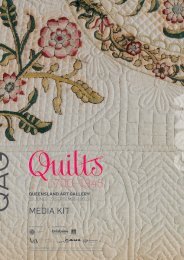Queensland Art Gallery - Queensland Government
Queensland Art Gallery - Queensland Government
Queensland Art Gallery - Queensland Government
Create successful ePaper yourself
Turn your PDF publications into a flip-book with our unique Google optimized e-Paper software.
Jun Nguyen-Hatsushiba<br />
Breathing is free<br />
Central to Jun Nguyen-Hatsushiba’s work is the socioeconomic change<br />
brought to postwar Vietnam by the rising tide of globalisation. In<br />
considering this issue, however, the artist takes a broad view; he does<br />
not identify himself with one single country making up his heritage —<br />
Japan (his mother’s country, and where he was born), the United States<br />
(where he was raised), or Vietnam (his father’s country and where he<br />
has lived since 1997). Rather, he moves fluidly between them, drawing<br />
on all three cultures. Nguyen-Hatsushiba’s memorials to the plights of<br />
his compatriots — the ‘boat people’ who left Vietnam to seek freedom,<br />
only to become refugees — are attempts at ensuring the problems of<br />
refugees worldwide are in the forefront of peoples’ minds.<br />
Nguyen-Hatsushiba’s practice has taken multiple forms since<br />
1994, with his drawings, sculptures, performances and installations<br />
consistently referencing local motifs such as rice, mosquito nets,<br />
dragons and cyclos. His ‘Memorial project’ video series, a suite of<br />
four films shot between 2001 and 2003, is particularly noteworthy 1 —<br />
Nguyen-Hatsushiba aligned imagery of figures floating underwater<br />
with acts of mourning victims of war and environmental destruction.<br />
This poetic approach, alerting audiences to social concerns, has<br />
brought him wide acclaim internationally.<br />
The video work The Ground, the Root, and the Air: The Passing of<br />
the Bodhi Tree 2004–07 was realised in cooperation with 50 students<br />
from the School of Fine <strong>Art</strong>s in Luang Prabang in Laos, an ancient<br />
city experiencing the influence of global market forces. However, it<br />
differs from Nguyen-Hatsushiba’s ‘Memorial project’ series in that<br />
its social messages are treated more abstractly, contributing to its<br />
beauty and lyricism.<br />
Hatsushiba aims to run the shortest distance to the other side of the<br />
earth (12 756.3 kilometres, the earth’s diameter), as a metaphor for<br />
the refugee’s unfulfilled wish to escape to the polar opposite of their<br />
circumstances. The bodies of his performers are subjected to tough<br />
conditions, entering territory somewhat beyond their control. Air is a<br />
metaphor for freedom in Nguyen-Hatsushiba’s work; breathing is free,<br />
indeed. People struggle underwater, on the ground, or in the river, to<br />
release themselves and to find freedom, and when they finally do, it<br />
offers a vision of hope for the future.<br />
Jun Nguyen-Hatsushiba encourages a realist approach to his work:<br />
‘My work might look political, but I am not here to take sides on<br />
which perspective is correct’. 2 The magic of art does not lie in political<br />
correctness or in the direct quotation of a real situation. It is far more<br />
effective to engage viewers through beauty based on reality and<br />
tangibility. In examining society’s realities, Nguyen-Hatsushiba says,<br />
‘what I need to create at the end must present itself as magic’. 3<br />
Shihoko Iida<br />
Endnotes<br />
1 Memorial Project Nha Trang, Vietnam: Towards the complex — For the courageous,<br />
the curious, and the cowards 2001; Happy New Year: Memorial Project Vietnam II<br />
2003; Ho! Ho! Ho! Merry Christmas: Battle of Easel Point — Memorial Project<br />
Okinawa 2003; and Memorial Project Minamata: Neither either nor neither — A love<br />
story 2002–03.<br />
2 Jun Nguyen-Hatsushiba, interview by Fernando Galán, art.es, no.1, 2004, p.59.<br />
3 Jun Nguyen-Hatsushiba, email to the author, 4 July 2008.<br />
The film features the students sketching the spectacular landscape<br />
along the Mekong River as they sweep along it on their wooden<br />
motorboats. When the boats near a sacred Bodhi tree on the<br />
riverbank, some of the students suddenly leap into the water and swim<br />
towards it, as if led by the Buddhist chants on the soundtrack. This act<br />
may be interpreted as the silent will of the Laotian people to maintain<br />
the flow of Buddha’s spirit, even as multinational capital pours into<br />
the country. It could also be read as an attempt to locate oneself in<br />
the great cycle of life, recognising that each one of us is a part of it.<br />
As the work approaches its serene yet dramatic climax, we gradually<br />
see these tensions appear and disappear in the drift of eternal time<br />
that the Mekong symbolises.<br />
The work of Nguyen-Hatsushiba both recognises history and steps<br />
into the future. He has worked with the people of Nha Trang in<br />
Vietnam, and Okinawa and Minamata in Japan — who bear the<br />
historical scars of war and pollution — inviting them to perform in his<br />
underwater works. In his ongoing running project, Breathing is free:<br />
12,756.3 for global refugee crisis, which he began in 2007, Nguyen-<br />
Jun Nguyen-Hatsushiba<br />
Japan/United States/Vietnam b.1968<br />
The Ground, the Root, and the Air: The Passing of the<br />
Bodhi Tree (stills) 2004–07<br />
High-definition digital video, single channel, colour,<br />
sound, 14:30 minutes / Courtesy: The artist and Mizuma<br />
<strong>Art</strong> <strong>Gallery</strong>, Tokyo / Images courtesy: The artist; The Quiet<br />
in the Land, Laos; Mizuma <strong>Art</strong> <strong>Gallery</strong>, Tokyo; Lehmann<br />
Maupin <strong>Gallery</strong>, New York / Photographs: Yukari Imai<br />
126 127
















